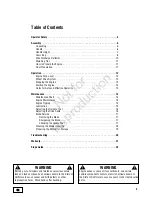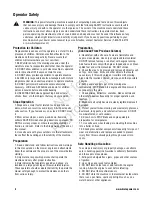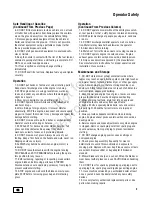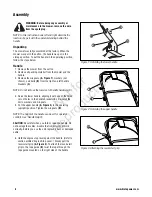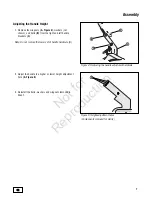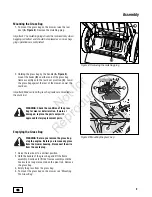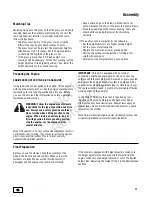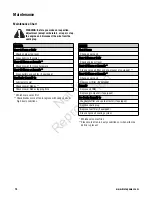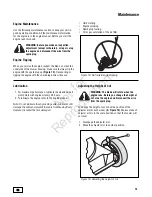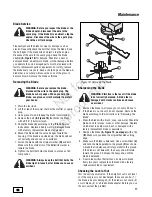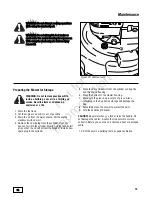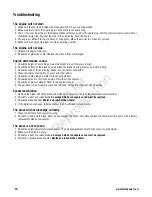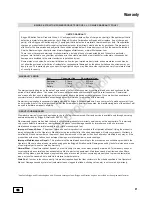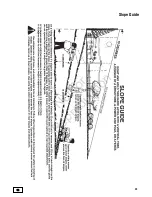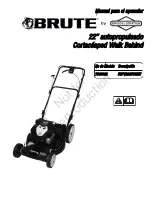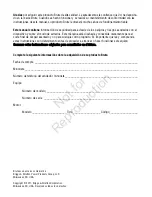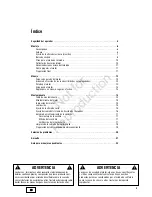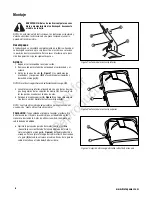
Blade Service
WARNING: Before you inspect the blade or the
blade adapter, disconnect the wire to the
spark plug. If the blade hits an object, stop the
engine. Disconnect the wire to the spark plug.
Check the unit for damage.
Frequently check the blade for wear or damage such as
cracks. Frequently check the bolt that holds the blade. Keep
the bolt tight. If the blade hits an object, stop the engine.
Disconnect the wire to the spark plug. Check the blade
adapter
(A, Figure 18)
for damage. Check for a bent or
damaged blade, a badly worn blade, or other damage. Before
you operate the unit, damaged parts must be replaced with
factory replacement parts or equivalent. For safety, replace
the blade every two years. Keep a sharp edge on the blade. A
blade that is not sharp will cause the ends of the grass to
become brown. Remove the blade as follows.
Removing the Blade
WARNING: Before you remove the blade,
disconnect the wire to the spark plug. The
blade has sharp edges. When you hold the
blade, use gloves or cloth material to protect
your hands.
1. Drain the fuel tank.
2. Lift the side of the mower that has the muffler or spark
plug.
3. Use a piece of wood to keep the blade from rotating.
4. Remove the bolt
(B, Figure 18)
that holds the blade
with a 9/16” (14mm) wrench.
5. Check the blade
(C)
according to the “Blade Service”
instructions. Replace a badly worn or damaged blade
with a factory replacement blade or equivalent.
6. Mount the blade with the curved edges toward the
housing. If the blade is upside down, the blade will not
cut correctly and can cause an accident.
7. Fasten the blade with the original washer
(D)
and bolt.
Make sure the outside rim of the Belleville washer is
toward the blade.
8. Tighten the bolt that holds the blade to a torque of 30
foot pounds.
WARNING: Always keep the bolt that holds the
blade tight. A loose bolt or blade can cause an
accident.
Sharpening the Blade
WARNING: Vibration is the result if the blade
is not correctly balanced. A blade that is
damaged with cracks can break and cause
an accident.
1. Sharpen the blade two times a year or every 25 hours.
2. If the blade is on the unit, do not sharpen. Remove the
blade according to the instructions in “Removing The
Blade”.
3. Clean the blade with a brush, soap, and water. Check the
blade. Look for cracks, nicks, or other damage. Replace
a blade that is badly worn, bent, or damaged with a
factory replacement blade or equivalent.
4. Sharpen the blade
(A, Figure 19, next page)
with a file
(B)
. Make sure you keep the original beveled cutting
edge.
5. Make sure the blade is balanced. Use a screwdriver
(C)
and hold the blade parallel to the ground
(D)
as shown.
A blade that is balanced will stay parallel to the ground.
If the blade is not balanced, the heavy end will rotate
toward the ground. Sharpen the heavy end until the
blade is balanced.
6. A new blade will cut better than a badly worn blade.
Every two years replace the old blade with a factory
replacement blade or equivalent.
Checking the Level of Cut
Test the unit in a small area. If the height of cut is not level
or if the cut grass is not discharged, the cause can be: (1)
the blade is bent or damaged, (2) the blade is not sharp, (3)
a worn blade, (4) or a broken blade adapter. Before you use
the unit, correct the problem.
Figure 18: Removing the blade
D
B
D
C
B
C
A
A
Maintenance
17
en
Not
for
Reproduction

